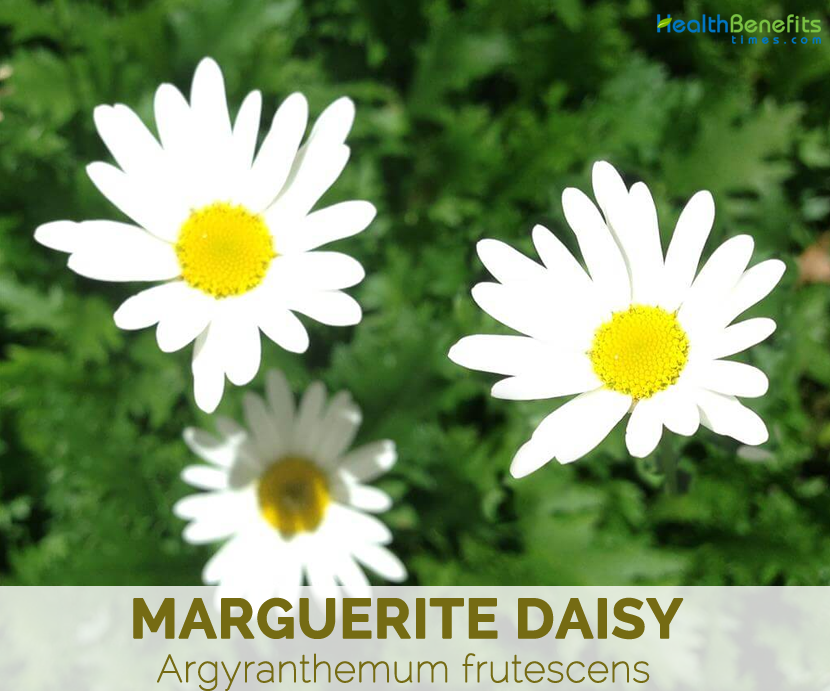| Marguerite Daisy Quick Facts | |
|---|---|
| Name: | Marguerite Daisy |
| Scientific Name: | Argyranthemum frutescens |
| Origin | Canary Islands in Macaronesia |
| Shapes | Subterete or obovoid achene |
| Health benefits | Beneficial for whooping cough, asthma, nervous excitability and conjunctivitis |
Plant Description
Marguerite Daisy is a short-lived, perennial herb or subshrub that grows about 60-180 cm tall. They can only survive under summer conditions with plenty of sun and cannot survive in areas that are cold and have no sunlight. The plants can grows easily in moderately fertile, medium-textured and well-drained soils. The plant has prostrated to erect, branched, glabrous stem. Leaves are alternate, 2–3 pinnately divided, lobes wedge-shaped to linear, ultimate margins serrated rarely entire. Pruning, pinching and deadheading help to maintain the shrub’s shape and encourage repeat blooming.
Flower & Fruit
Inflorescence a lax irregular cyme often reduced to a solitary capitulum. Involucre hemispherical cup-shaped, phyllaries in 3–4 series, free, persistent in fruit, oblanceolate or ovate to lanceolate-deltate or lanceolate, margins and tips yellow to brown, scarious, tips of inner often expanded; receptacle convex to conic. Ray flowers are 12 to >25, ray ovate to linear, female, white, sometimes pink or yellow. Disk flowers are 50–80 to >150, bisexual, fertile, corolla white, yellow (pink, red or purple), tubular, 5-deltoid lobed, anther with ovate tips, styler tip truncate, papillate. Fruit is sub terete or obovoid achene, faintly 5–8 ribbed without pappus.
These flowers grow in many different types of habitats. They are also most frequently used for borders of houses since they grow continuously. They are also known for long period of growth ranging from May to November.
Traditional uses and benefits of Marguerite Daisy
- Marguerite Daisy has been used in the treatment of whooping cough, asthma and nervous excitability.
- Sticky leaves have been used in wound dressing.
- An eye lotion for conjunctivitis can be made from the flowers.
Other Facts
- The species, cultivars and hybrids are planted as ornamental plants in gardens and parks.
- Flowers are also used for cut flower arrangements.
- Cut flowers are long-lasting in fresh bouquets.
- Daisies close their petals when the sun goes down at night.
References:
http://www.theplantlist.org/tpl1.1/record/gcc-38385
https://www.itis.gov/servlet/SingleRpt/SingleRpt?search_topic=TSN&search_value=184927#null
https://davesgarden.com/guides/pf/go/55228/
https://npgsweb.ars-grin.gov/gringlobal/taxonomydetail.aspx?id=317332
https://www.cabi.org/isc/datasheet/110364
http://www.missouribotanicalgarden.org/PlantFinder/PlantFinderDetails.aspx?kempercode=a488
https://en.wikipedia.org/wiki/Argyranthemum_frutescens
Comments
comments
